
Pinus nigra, the Austrian pine or black pine, is a moderately variable species of pine, occurring across Southern Europe from the Iberian Peninsula to the eastern Mediterranean, on the Anatolian peninsula of Turkey, Corsica and Cyprus, as well as Crimea and in the high mountains of Northwest Africa.

Abies concolor, the white fir, is a coniferous tree in the pine family Pinaceae. This tree is native to the mountains of western North America, including the Cascade Range and southern Rocky Mountains, and into the isolated mountain ranges of southern Arizona, New Mexico, and Northern Mexico. It naturally occurs at elevations between 900–3,400 metres (3,000–11,200 ft).
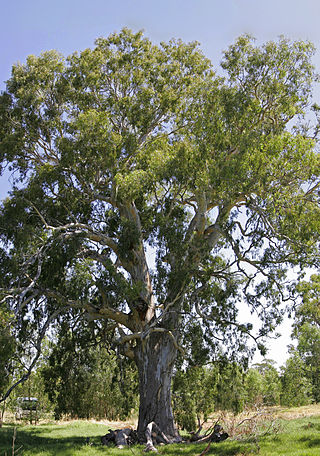
Eucalyptus camaldulensis, commonly known as the river red gum, is a species of flowering plant in the family Myrtaceae, and is endemic to Australia. It is a tree with smooth white or cream-coloured bark, lance-shaped or curved adult leaves, flower buds in groups of seven or nine, white flowers and hemispherical fruit with the valves extending beyond the rim. A familiar and iconic tree, it is seen along many watercourses across inland Australia, providing shade in the extreme temperatures of central Australia.
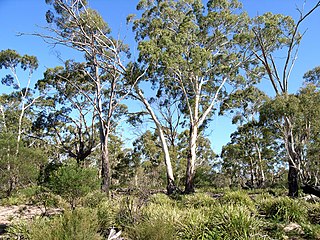
Eucalyptus viminalis, commonly known as the manna gum, white gum or ribbon gum, is a species of small to very tall tree that is endemic to south-eastern Australia. It has smooth bark, sometimes with rough bark near the base, lance-shaped to curved adult leaves, flower buds in groups of three or seven, white flowers and cup-shaped or hemispherical fruit.
Dipterocarpus acutangulus is a species of tree in the family Dipterocarpaceae. The species name acutangulus is derived from Latin and refers to the ribs of the fruit calyx tube. It is native to peninsular Thailand and Malaysia and also Borneo, where it is locally known as keruing merkah or keruing beludu. It is an emergent tree up to 60 m tall. The tree occurs in mixed dipterocarp forests found on sandy and sandy clay soils on coastal hills and inland ridges, up to 1000 m elevation. It occurs in at least one protected area.

Banksia integrifolia, commonly known as the coast banksia, is a species of tree that grows along the east coast of Australia. One of the most widely distributed Banksia species, it occurs between Victoria and Central Queensland in a broad range of habitats, from coastal dunes to mountains. It is highly variable in form, but is most often encountered as a tree up to 25 metres (82 ft) in height. Its leaves have dark green upper surfaces and white undersides, a contrast that can be striking on windy days.

Banksia integrifolia subsp. monticola, commonly known as White Mountain banksia, is a subspecies of Banksia integrifolia. Described in 1994, it occurs in the Blue Mountains and in northern New South Wales. It contains the largest recorded Banksia trees.
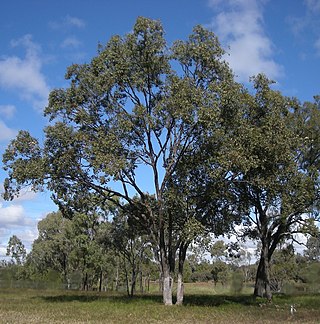
Eucalyptus populnea, commonly known as poplar box, bimble box or bimbil box, is a species of small to medium-sized tree that is endemic to eastern Australia. It has rough, fibrous or flaky bark on the trunk and branches, egg-shaped, elliptical or more or less round leaves, flower buds arranged in groups of seven to fifteen or more, white flowers and conical, hemispherical or cup-shaped fruit.
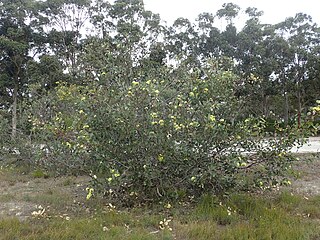
Eucalyptus preissiana, commonly known as bell-fruited mallee, is a species of small tree or shrub that occurs in an area between Albany and Esperance in Western Australia. It has a spreading habit, smooth bark, elliptical to egg-shaped or oblong leaves, flower buds in groups of three, yellow flowers and cup-shaped, conical or bell-shaped fruit.
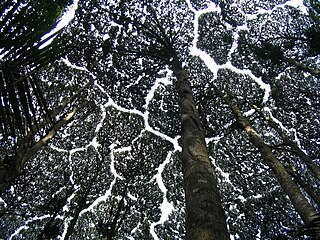
Dryobalanops aromatica, commonly known as Borneo camphor, camphor tree, Malay camphor, or Sumatran camphor, is a species of critically endangered plant in the family Dipterocarpaceae. The species name aromatica is derived from Latin and refers to the smell of the dammar (resin). This species was one of the main sources of camphor and attracted early Arab traders to Borneo, at that time being worth more than gold, and used for incense and perfumes.
Dryobalanops oblongifolia is a species of plant in the family Dipterocarpaceae, native to regions of Southeast Asia and Maritime Southeast Asia.
Shorea agamii is a species of plant in the family Dipterocarpaceae. The species is named after J. Agama a one time forest officier in the Sabah Forestry Department. Two subspecies are recognised subsp. agamii and subsp diminuta. The subspecies name diminuta is derived from Latin and refers to the smaller leaves of this subspecies.
Shorea crassa is a species of plant in the family Dipterocarpaceae. The species name is derived from Latin and refers to thick leaf blade.

Dipterocarpus condorensis is a species of plant in the evergreen or semi-evergreen family Dipterocarpaceae.
Dipterocarpus conformis is a species of plant in the family Dipterocarpaceae. The species is named derived from Latin and alludes to the great similarity in vegetative characters with two other large-leaved Dipterocarpus species. There are two subspecies; D. conformis subsp. conformis which is confined to Aceh and North Sumatra and D. conformis subsp. borneensis which is confined to Borneo. D. conformis subsp. borneensis is an emergent tree, up to 50 m tall, in mixed dipterocarp forest on clay soils over shale. It is a medium hardwood sold under the trade names of Keruing.

Drosera gigantea, the giant sundew, is an erect perennial tuberous species in the carnivorous plant genus Drosera that is endemic to Western Australia. It grows in sandy soils at the margins of swamps and near granite outcrops along the Western Australian coast from Albany north to just south of Geraldton. D. gigantea produces small shield-shaped leaves along many lateral branches that look like a small tree. Individual plants can grow up to 0.2–1 m (0.7–3.3 ft) tall. Because of its tall, tree-like form, it is considered one of the largest Drosera species. It is also easily cultivated and enjoys damp, humid conditions often provided in greenhouses. White flowers emerge from August to November. The red tubers of this species can grow to be 3.8 cm (1.5 in) in diameter and may be a metre below ground.

Eucalyptus loxophleba, commonly known as York gum, daarwet, goatta, twotta or yandee, is a species of tree or mallee that is endemic to Western Australia. It has rough bark on the trunk, smooth olive to brownish bark above, lance-shaped adult leaves, flowers buds in groups of between seven and eleven, white flowers and conical fruit.
Grevillea brachystylis grandis, commonly known as large-flowered short-styled grevillea, is a subspecies of Grevillea brachystylis.

Corymbia cadophora, commonly known as twinleaf bloodwood, is a species of small, straggly tree that is endemic to the Kimberley region of Western Australia. It has rough bark on the trunk and branches, a crown of sessile, egg-shaped or lance-shaped leaves joined in opposite pairs, flower buds mostly arranged in groups of seven, creamy white to pink or red flowers and urn-shaped to barrel-shaped fruit.
Caustis blakei, also known as the koala fern, is a species of rhizomatous sedge in the family Cyperaceae. It is found exclusively in Australia in southeastern Queensland and northeastern New South Wales. It has rigid, smooth stems up to 2 meters with 10 to 28 nodes. It has two subspecies: C. blakei subsp. blakei and C. blakei subsp. macrantha, which was identified by Johnston et al. in 1997. The two subspecies differ in length of spikelets, anthers, and fruit.












